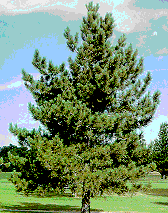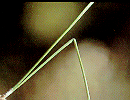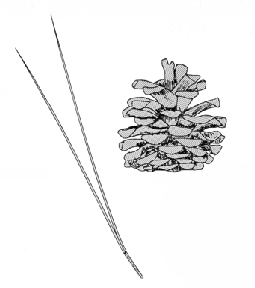Pinus resinosa
 The red pine is a
native of the Lake states and eastward throughout New England and southeastern Canada. It had not
been planted widely in Iowa until the 1930's. Since then it has been planted quite widely for both
erosion control and water conservation , and some for farmstead windbreaks. When growing under
natural conditions, the red pine reaches a height of 90 to 100 feet and a diameter of 30 to 40
inches, with a tall, straight, clean trunk and an open, rounded picturesque crown. The tree gets
its name from the bright orange-colored or reddish bark, which divides into large plates as the
tree matures.
The red pine is a
native of the Lake states and eastward throughout New England and southeastern Canada. It had not
been planted widely in Iowa until the 1930's. Since then it has been planted quite widely for both
erosion control and water conservation , and some for farmstead windbreaks. When growing under
natural conditions, the red pine reaches a height of 90 to 100 feet and a diameter of 30 to 40
inches, with a tall, straight, clean trunk and an open, rounded picturesque crown. The tree gets
its name from the bright orange-colored or reddish bark, which divides into large plates as the
tree matures.
 Red pine
needles are 4 to 6 inches long and in bundles of two. The dark green needles are soft and flexible.
When bent sharply they snap or break cleanly rather than just folding over as do the needles of
other pines.
Red pine
needles are 4 to 6 inches long and in bundles of two. The dark green needles are soft and flexible.
When bent sharply they snap or break cleanly rather than just folding over as do the needles of
other pines.
 The cone is
egg-shaped; 2 to 2-1/4 inches long. The cone scales are smooth and without spines. The seeds are
eaten by songbirds and small animals.
The cone is
egg-shaped; 2 to 2-1/4 inches long. The cone scales are smooth and without spines. The seeds are
eaten by songbirds and small animals.
Branching: Each year a pine tree produces a new whorl (circle) of branches.
Bark: reddish cast, breaking up into scaly plates
Height: 50 to 80 ft.
Trunk Diameter: 1 to 3 ft.
Longevity: maximum age is about 350 yrs.
Tolerance: intermediate
Range: southern Canada, lake states, and the northeast
Fun Facts:
- Most of the wooden telephone poles in Michigan and surrounding states are red pine.
- Used to make log cabins.
- During the Depression in the 1930s, millions of red pine plantations were planted by the C.C.C. (Civilian Conservation Corps.); that is the reason we see so many in Camp Conestoga.
![]()